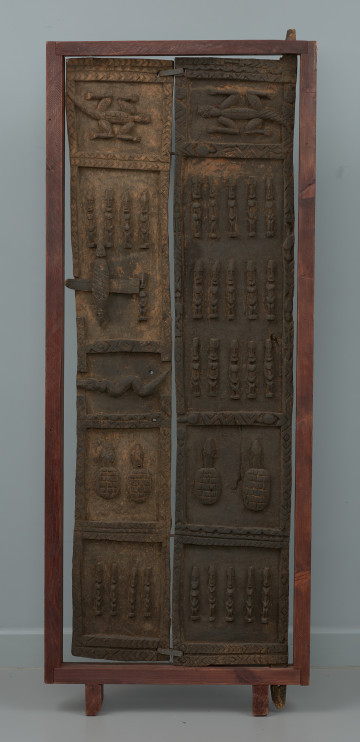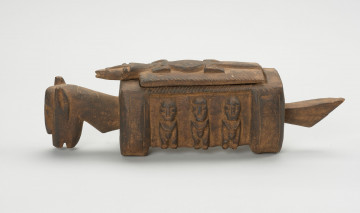
Door
między 1970 — 1980
National Museum in Szczecin
Part of the collection: Collection of Dogonian art
At the creation of the Sun, Amma, transforming a fragment of the placenta of Yurugu, one of his children, brought into existence the turtle agunuru. Its structure is a microscopic reflection of the world. The carapace, or hard dorsal shell, called agunuru koro in the Dogo-so language, represents the celestial world, while the plastron (lower, ventral part) of agunuru bene is a representation of the Earth. The liver of the tortoise symbolises the Sun, whose creation it witnessed. Desert tortoises (Centrochelys sulcata) of the terrapin family (Testudinidae) can be found in Dogon country. These are large reptiles reaching up to half a metre in length and weighing around 50 kilograms. They are characterised by their great strength. Agunuru often live in Dogon enclosures. They do not move freely in them, they only have a separate area surrounded by a wall. In this wall there is a special opening leading into the bush, making it easier for the tortoises to enter and leave the enclosure. Tortoises are highly respected animals. The Dogon call them guardians of the world and remember the role their ancestor played in the creation of the world. The Dogon also trust agunuru to guard their villages and homesteads. When the head of the family goes on a journey, his role is taken over by a tortoise. It then gets its first meal before the other members of the family have even eaten. According to the Dogon, tortoises belong to the Yeban, the creatures of the bush. Their skulls are often placed in horizontal rock crevices next to burial sites. The figurine is part of a fortune-telling set. The Dogon, like other peoples (not only African), like to know the near future and often consult their undertakings with fortune-tellers.
Ewa Prądzyńska
Author / creator
Dimensions
cały obiekt: height: 3,5 cm, width: 6,5 cm
Object type
figure
Creation time / dating
Creation / finding place
Identification number
Location / status

między 1970 — 1980
National Museum in Szczecin
około 1970
National Museum in Szczecin

między 1951 — 2000
National Museum in Szczecin
DISCOVER this TOPIC
National Museum in Szczecin
DISCOVER this PATH
Educational path